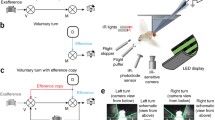Summary
In theDrosophila mutantoptomotorblind H31 (omb H31), previously isolated for its defects in the optomotor turning response, the visual giant neurons of the lobula plate are missing or significantly reduced. In particular, fibres homologous to the H-and V-cells ofCalliphora as well as two fibres (M-cells) in the middle plane of the plate are affected.
Optomotor turning reactions in flight and in the walking mode are strongly reduced inomb H31. Also pattern induced orientation is disturbed. In flight this behavior is thought to be controlled by 3 parameters: the response to the position of the pattern, the response to the direction of motion of the pattern and the spontaneous torque fluctuations of the fly. All of these are reduced in the mutant.
Two other visual reactions, the optomotor thrust response and the movement-stimulated landing response can readily be elicited. Althoughomb H31 and wild type differ in certain properties of these responses preliminary experiments indicate that in both cases the response strength is not significantly reduced by the mutation.
These findings confirm the rôle of the H-cells in optomotor turning reactions but question the suggestions based on anatomical and electrophysiological results from big flies that the V-cells are mediating the optomotor thrust response.
Similar content being viewed by others
References
Blest, A.D.: Some modifications of Holm's silver method for insect central nervous system. Quart. J. micr. Sci.102, 413–417 (1961)
Blondeau, J.: Electrically evoked motor activity in the fly (Calliphora erythrocephala). Doctoral thesis, Eberhard-Karls-Universität, Tübingen 1977
Buchner, E.: Elementary movement detectors in an insect visual system. Biol. Cybernetics24, 85–101 (1976)
Dvorak, D.R., Bishop, L.G., Eckert, H.E.: On the identification of movement detectors in the fly optic lobe. J. comp. Physiol.100, 5–23 (1975)
Geiger, G.: Short term learning in flies. Naturwissenschaften11, 539 (1975)
Götz, K.G.: Optomotorische Untersuchung des visuellen Systems einiger Augenmutanten der FruchtfliegeDrosophila. Kybernetik2, 77–92 (1964)
Götz, K.G., Wenking, H.: Visual control of locomotion in the walking fruitflyDrosophila. J. comp. Physiol.85, 235–266 (1973)
Hausen, K.: Struktur, Funktion und Konnektivität bewegungsempfindlicher Interneurone im dritten optischen Neuropil der SchmeißfliegeCalliphora erythrocephala. Doctoral thesis, Eberhard-Karls-Universität, Tübingen 1976
Heisenberg, M.: Behavioral diagnostics; a way to analyze visual mutants. In: Information processing in the visual system of arthropods (ed. R. Wehner), pp. 265–268. Berlin-Heidelberg-New York: Springer 1972
Heisenberg, M., Buchner, E.: The rôle of retinula cell types in visual behavior ofDrosophila melanogaster. J. comp. Physiol.117, 127–162 (1977)
Heisenberg, M., Götz, K.G.: The use of mutations for the partial degradation of vision inDrosophila melanogaster. J. comp. Physiol.98, 217–241 (1975)
Pierantoni, R.: A look into the cock-pit of the fly. The architecture of the lobula plate. Cell Tiss. Res.171, 101–122 (1976)
Poggio, T., Reichardt, W.: A theory of the pattern induced flight orientation of the flyMusca domestica. Kybernetik12, 185–203 (1973)
Reichardt, W.: Musterinduzierte Flugorientierung. Verhaltensversuche an der FliegeMusca domestica. Naturwissenschaften60, 122–138 (1973)
Reichardt, W., Poggio, T.: Visual control of orientation behavior in the fly. Part I. A quantitative analysis. Quart. Rev. Biophys.9, 311–375 (1976)
Srinivasan, M.V.: A visually-evoked roll response in the housefly. Open-loop and closed-loop studies. J. comp. Physiol.119, 1–14 (1977)
Author information
Authors and Affiliations
Additional information
The mutantomb H31 was isolated at the Max-Planck-Institut für biologische Kybernetik, Tübingen in the laboratory of Prof. K.G. Götz who supported this work with suggestions, enthusiasm and instruments. Dr. E. Buchner and C. Straub generously contributed their optomotor thrust experiments. We are further indepted to Dr. J. Blondeau, Dr. E. Buchner, Dr. K.-F. Fischbach, Prof. K. Kirschfeld and Prof. W. Reichardt for critical comments and in particular to Mrs. K. Schulze for preparing the manuscript. This work was supported by a grant from Deutsche Forschungsgemeinschaft to M.H.
Rights and permissions
About this article
Cite this article
Heisenberg, M., Wonneberger, R. & Wolf, R. Optomotor-blindH31—aDrosophila mutant of the lobula plate giant neurons. J. Comp. Physiol. 124, 287–296 (1978). https://doi.org/10.1007/BF00661379
Accepted:
Issue Date:
DOI: https://doi.org/10.1007/BF00661379




